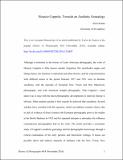Files in this item
Horacio Coppola : towards an aesthetic genealogy
Item metadata
| dc.contributor.author | Kefala, Eleni | |
| dc.date.accessioned | 2018-06-12T23:32:38Z | |
| dc.date.available | 2018-06-12T23:32:38Z | |
| dc.date.issued | 2016 | |
| dc.identifier | 247678045 | |
| dc.identifier | 207deed8-5662-4d42-a48d-2e9a95802fdc | |
| dc.identifier | 85006166589 | |
| dc.identifier | 000390816800003 | |
| dc.identifier.citation | Kefala , E 2016 , ' Horacio Coppola : towards an aesthetic genealogy ' , History of Photography , vol. 40 , no. 4 , pp. 388-412 . https://doi.org/10.1080/03087298.2016.1236887 | en |
| dc.identifier.issn | 0308-7298 | |
| dc.identifier.other | ORCID: /0000-0002-4532-6253/work/49052092 | |
| dc.identifier.uri | https://hdl.handle.net/10023/13979 | |
| dc.description | Funding: Arts and Humanities Research Council (AHRC) under Grant AH/J004790/1. | en |
| dc.description.abstract | Although a milestone in the history of Latin American photography, the work of Horacio Coppola is little known outside Argentina. His unorthodox angles and tilting frames, his attention to industrial and urban themes, and his experimentation with different lenses in the period between 1927 and 1931 were in absolute synchrony with the precepts of European New Vision and New Objectivity photography, and with American straight photography. That Coppola’s visual idiom was in tune with the latest photographic developments in interwar Europe is obvious. What remains unclear is how exactly he achieved that synchrony. Several scholars have wrestled with this question, which nevertheless remains elusive due to lack of evidence of direct contact with European photography prior to his studies at the Berlin Bauhaus in 1932 and his repeated attempts to downplay the influence contemporary photographers had on his work. The article provides a systematic study of Coppola’s aesthetic genealogy and his photographic borrowings through a critical examination of his early pictures and theoretical writings. It teases out possible direct and indirect channels of dialogue with the New Vision, New Objectivity, and straight photography in the second half of the 1920s, and probes the reasons behind Coppola’s reluctance to admit a connection with contemporary European photography in particular. | |
| dc.format.extent | 1290228 | |
| dc.language.iso | eng | |
| dc.relation.ispartof | History of Photography | en |
| dc.subject | Alfredo Guttero (1882–1932) | en |
| dc.subject | José Ortega y Gasset (1883–1955) | en |
| dc.subject | Le Corbusier (1887–1965) | en |
| dc.subject | Horacio Coppola (1906–2012) | en |
| dc.subject | Argentina | en |
| dc.subject | New Vision | en |
| dc.subject | New Objectivity | en |
| dc.subject | Straight photography | en |
| dc.subject | Avant-garde | en |
| dc.subject | Buenos Aires | en |
| dc.subject | Latin America | en |
| dc.subject | 1920s | en |
| dc.subject | 1930s | en |
| dc.subject | DP Spain | en |
| dc.subject | F1201 Latin America (General) | en |
| dc.subject | T Technology | en |
| dc.subject | BDC | en |
| dc.subject | R2C | en |
| dc.subject.lcc | DP | en |
| dc.subject.lcc | F1201 | en |
| dc.subject.lcc | T | en |
| dc.title | Horacio Coppola : towards an aesthetic genealogy | en |
| dc.type | Journal article | en |
| dc.contributor.sponsor | Arts and Humanities Research Council | en |
| dc.contributor.institution | University of St Andrews. Spanish | en |
| dc.contributor.institution | University of St Andrews. Centre for Poetic Innovation | en |
| dc.identifier.doi | https://doi.org/10.1080/03087298.2016.1236887 | |
| dc.description.status | Peer reviewed | en |
| dc.date.embargoedUntil | 2018-06-12 | |
| dc.identifier.grantnumber | AH/J004790/1 | en |
This item appears in the following Collection(s)
Items in the St Andrews Research Repository are protected by copyright, with all rights reserved, unless otherwise indicated.

